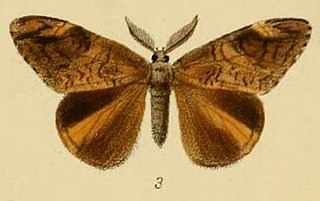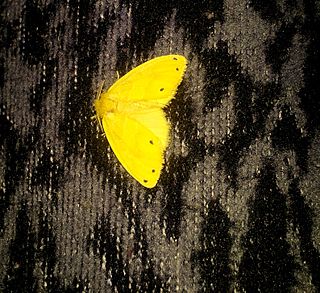
Olepa is a genus of moths in the family Erebidae. The genus was described by Watson in 1980. Most part of species occur in India and Sri Lanka, though one species was described from Israel.
Protrigonia is a monotypic moth genus of the family Crambidae erected by George Hampson in 1896. It contains only one species, Protrigonia zizanialis, described by Charles Swinhoe in 1886, which is found in Sri Lanka and western India.
Dunira is a genus of moths of the family Erebidae. The genus was erected by Frederic Moore in 1885.

Aroa is a genus of moths in the subfamily Lymantriinae first described by Francis Walker in 1855. Species are distributed in South Africa, China, throughout India, Sri Lanka, Myanmar, and Java.

Artaxa is a genus of tussock moths in the family Erebidae erected by Francis Walker in 1855. Some of the species have urticating hairs.

Dysphania is a genus of colourful moths in the family Geometridae and typical of the tribe Dysphaniini; they are sometimes called 'false tiger moths' and are found in northeast Australia, Melanesia, and south, east and southeast Asia.
Goniocraspedon mistura is a moth of the family Noctuidae first described by Charles Swinhoe in 1891. It is found in India, Sri Lanka and Australia.
Lymantria subrosea is a moth of the family Erebidae first described by Francis Walker in 1855. It is found from Sri Lanka to China and Sundaland, the Philippines, Sulawesi, Seram, the Lesser Sundas to Timor. The Sumatran population is categorized under the subspecies, Lymantria subrosea singapura.
Cacochloris uvidula is a moth of the family Geometridae first described by Swinhoe in 1885. It is found in India and probably in Sri Lanka.
Chrysocraspeda tristicula is a moth of the family Geometridae first described by Swinhoe in 1885. It is found in Sri Lanka. India, Myanmar, Borneo, Philippines and Sumbawa.
Chalioides vitrea is a moth of the family Psychidae first described by Swinhoe in 1892. It is found in Oriental regions of India and Sri Lanka.
Lophothripa vitea is a moth of the family Nolidae first described by Swinhoe in 1885. It is found in Indo-Australian tropics towards the Solomon Islands.
Nola analis is a moth of the family Nolidae first described by Wileman and West in 1928. It is found in India, Sri Lanka and Hong Kong.
Nola fuscibasalis is a moth of the family Nolidae first described by George Hampson in 1896. It is found in Sri Lanka and Myanmar.
Nola leucoscopula is a moth of the family Nolidae first described by George Hampson in 1907. It is found in Sri Lanka.
Nola lucidalis is a moth of the family Nolidae first described by Francis Walker in 1864. It is found in the Indian subregion, Sri Lanka, Borneo, Java, the Philippines and Taiwan.
Nola mesotherma is a moth of the family Nolidae first described by George Hampson in 1909. It is found in Sri Lanka.
Nola rufimixta is a moth of the family Nolidae first described by George Hampson in 1909. It is found in India and Sri Lanka.
Nola streptographia is a moth of the family Nolidae first described by George Hampson in 1900. It is found in Sri Lanka.
Nola squalida is a moth of the family Nolidae first described by Otto Staudinger in 1870. It is found in Turkestan, Himalaya, Sikkim, Bhutan, China, India and Sri Lanka.



